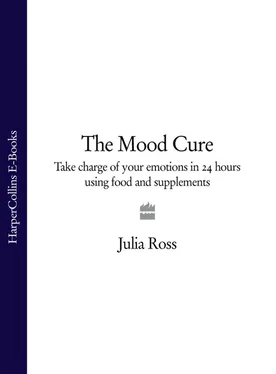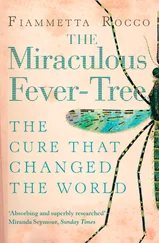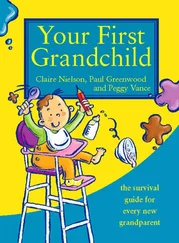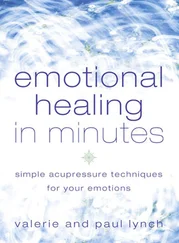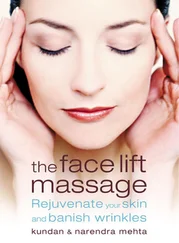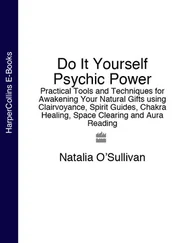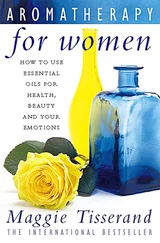2Is your drive, enthusiasm, and motivation quota on the low side?
3Do you have difficulty focusing or concentrating?
3Do you need a lot of sleep? Are you slow to wake up in the morning?
3Are you easily chilled? Do you have cold hands or feet?
2Do you tend to put on weight too easily?
3Do you feel the need to get more alert and motivated by consuming a lot of coffee or other “uppers” like sugar, diet soda, ephedra, or cocaine?
Total__________ If your score is more than 6 in part 2, turn to chapter 4, page 53.
Part 3. Is Stress Your Problem?
3Do you often feel overworked, pressured, or deadlined?
1Do you have trouble relaxing or loosening up?
1Does your body tend to be stiff, uptight, tense?
2Are you easily upset, frustrated, or snappy under stress?
3Do you often feel overwhelmed or as though you just can’t get it all done?
2Do you feel weak or shaky at times?
3Are you sensitive to bright light, noise, or chemical fumes? Do you need to wear dark glasses a lot?
3Do you feel significantly worse if you skip meals or go too long without eating?
2Do you use tobacco, alcohol, food, or drugs to relax and calm down?
Total__________ If your score is more than 8 in part 3, turn to chapter 5, page 77.
Part 4. Are you Too Sensitive to Life’s Pain?
3Do you consider yourself or do others consider you to be very sensitive? Does emotional pain or perhaps physical pain really get to you?
2Do you tear up or cry easily—for instance, even during TV commercials?
2Do you tend to avoid dealing with painful issues?
3Do you find it hard to get over losses or get through grieving?
2Have you been through a great deal of physical or emotional pain?
3Do you crave pleasure, comfort, reward, enjoyment, or numbing from treats like chocolate, bread, wine, romance novels, marijuana, tobacco, or lattes?
Total_________ If your score is more than 6 in part 4, turn to chapter 6, page 100.
True-Life Stories of the Four False Mood Types
Cara had a typical case of the “dark clouds.” She’d been low in confidence all her life. She was a doer, though—her underwear drawer was a work of art, and her boss adored her perfect projects and reports (not that she was ever satisfied herself). She worried a lot and woke up in the night feeling panicky at times. She had recently started to feel really depressed and had tried an antidepressant but hadn’t liked its side-effects, though it had lifted her mood a bit. She’d tried therapy, but hadn’t had much to talk about—she’d come from a close, warm family, and her adult life had gone fairly well. She was out of luck till she came to our clinic and completed her mood profile, which showed that she had almost every symptom in part 1! She left with some targeted brain repair supplements and the next day called to report the best night’s sleep and the best morning mood she’d had in years.
Emma was too lethargic to clean up her underwear drawer. She had “the blahs,” the kind of low-energy depression that too often made her unmotivated, unexcited, and unfocused. She was sick of being an emotional flatliner, but she had no idea what was wrong or what to do about it. We did, though. We could see that she needed our most brain-stimulating nutrient supplements. Fifteen minutes after she took them, we could see that she was feeling more like the person she was meant to be: humorous, sharp, and more alert. This became a permanent state of being for her after a few months of nutritional brain repair work and a revitalization of her thyroid function.
Rob had plenty of drive and energy, but he was a real “stress” type. Years of sixty-to-eighty-hour workweeks, too much coffee and fast food, and too many skipped meals, plus a drawn-out child custody battle, had turned him into a tense, wired, and tired mess. He was clearly sinking into adrenal burnout. On his new antistress supplements and regular meals, he was able to cut out his coffee without a backward glance, cut back his work hours, and begin to feel like a new man.
Sam was “too sensitive.” He teared up whenever he talked about anything painful. He avoided hashing out problems with his wife because it was just too uncomfortable for him. Instead, he tuned out with a beer or a bowl of ice cream in front of the TV. Things started to change when we recommended some supplements that allowed him to tolerate pain more easily and enjoy life a lot more (without either the beer or the ice cream). Then, when he was no longer overly sensitive, we recommended couples therapy, which he was then able to tolerate and even enjoy.
Now that you’ve completed and tallied the questionnaire, you’ve taken the first step in your Mood Cure: you know which false mood type (or types) you are. Having this crucial information will allow you to move on to step two, “Eliminating the Four Most Common Mood Imbalances.” There you will discover what is causing you to have a particular set of false moods and what you can do about it. At the bottom of each part of the questionnaire, next to your score, you’ll find the page number of the chapter that will tell you more about your symptoms and all about the solutions to that particular mood type’s problem. For example, if you find yourself checking off symptoms in part 1, “Are You Under a Dark Cloud?” you’ll turn to chapter 3, “Lifting the Dark Cloud.” Each chapter ends with “Action Steps” that summarize all its suggestions, to make them easy to follow.
If you recognize significant symptoms in two, three, or all four parts of the questionnaire, you’ll read each of the corresponding chapters. If your score is under the cut-off number in any part of the questionnaire and the symptoms you do identify with are significant, look over the relevant chapter to explore further.
Next you’ll move on to step three, “Creating Your Nutritherapy Master Plan.” There you’ll learn about the good-mood foods that will become the heart of your diet and about how to avoid the bad-mood foods. I’ll make it easy for you by providing simple and tasty menus and recipes.
Step three also features a master supplement plan that will provide you with several key pieces of your Mood Cure. First, it describes the basic vitamins, minerals, and other nutrients that I want you to make a permanent part of your life. Second, it warns you of anything that might make it unwise for you to take a particular supplement. Finally, it provides a master list of all the special repair supplements recommended in each chapter of the book. You’ll copy this list and check off just the items you’ll be using for your own supplement plan. Then you’ll take your list to the store, get your supplies, start taking your supplements, eat your good-mood foods, and watch your false moods slip away.
As you work through steps two and three of The Mood Cure , you may find that you have other mood-related troubles beyond the big four and a mood-poor diet. Step four, “Getting Help with Special Mood Repair Projects,” provides the answers if you have questions about sleep difficulties, addiction problems, or alternatives to antidepressant medications.
Читать дальше
